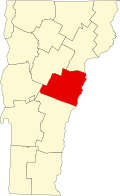History
One of the New Hampshire grants, Fairlee was chartered by Governor Benning Wentworth on September 9, 1761, and awarded to Josiah Channey, Joseph Hubbard and 62 others. [6] It was first settled in 1766. On February 25, 1797, the western half of the grant was set off as West Fairlee.
The population was 575 by 1859, when it had several sawmills, a gristmill, and an establishment for lead pipe and pumps. [6]
The Fairlee Railroad Depot was built in 1848 by the Connecticut & Passumpsic Rivers Railroad. Listed on the National Register of Historic Places in 1998, it is the oldest surviving railroad structure along the Connecticut River. [7]
Demographics
As of the census [2] of 2000, there were 967 people, 395 households, and 265 families living in the town. The population density was 47.9 people per square mile (18.5/km2). There were 575 housing units at an average density of 28.5 per square mile (11.0/km2). The racial makeup of the town was 97.52% White, 0.21% African American, 0.10% Native American, 0.52% Asian, 0.21% from other races, and 1.45% from two or more races. Hispanic or Latino people of any race were 0.83% of the population.
There were 395 households, out of which 31.4% had children under the age of 18 living with them, 54.2% were married couples living together, 7.8% had a female householder with no husband present, and 32.7% were non-families. 25.1% of all households were made up of individuals, and 10.1% had someone living alone who was 65 years of age or older. The average household size was 2.42 and the average family size was 2.88.
In the town, the population was spread out, with 23.6% under the age of 18, 7.2% from 18 to 24, 28.3% from 25 to 44, 25.4% from 45 to 64, and 15.4% who were 65 years of age or older. The median age was 41 years. For every 100 females, there were 96.9 males. For every 100 females age 18 and over, there were 96.5 males.
The median income for a household in the town was $44,018, and the median income for a family was $48,250. Males had a median income of $31,736 versus $25,217 for females. The per capita income for the town was $18,454. About 2.6% of families and 5.6% of the population were below the poverty line, including 4.7% of those under age 18 and 13.4% of those age 65 or over.
This page is based on this
Wikipedia article Text is available under the
CC BY-SA 4.0 license; additional terms may apply.
Images, videos and audio are available under their respective licenses.






